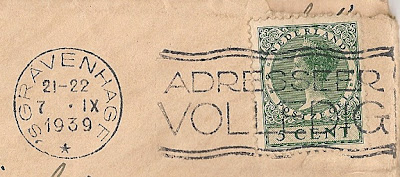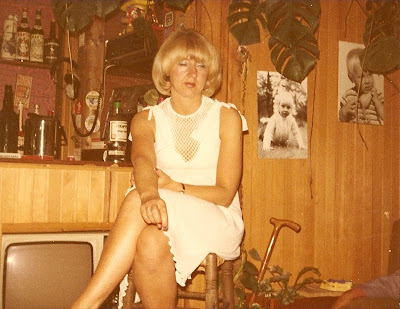In the previous post about Dutch postmarks I showed you a number of these government or Post Office sponsored messages. Usually the idea behind them is to draw attention to a certain subject or to trigger some reaction. In Dutch these stamps are called 'flag stamps' (vlagstempels).
 |
| September 7, 1939: Adresseer volledig |
The text on this first stamp intends to stimulate writers to mention the full address on their correspondence. This sounds silly but it wasn't. When people wrote a letter to someone in the same city or village, many were accustomed to write a persons' name and street but in stead of mentioning the city name, they said ' City' or 'Local'. That may seem rather odd but in those days it was not unusual that your social circle did not extend beyond the borders of the place where you lived. And when such a letter erroneously ended up in the wrong mail bag...
 |
| September 23, 1939: Goedkoope brief-telegrammen |
 |
| October 21, 1939: Postzegels-rechts boven in den hoek Vlugger verzending |
 |
| October 25, 1939: Post Uw brieven zoodra ze gereed zijn! |
 |
| August 29, 1941 Elke bosch- of heidebrand is verlies voor stad en land |
 |
| February 12, 1942: Ook straatnaam en huisnummer in het adres Adresseer volledig |
Apparently it was still necessary to ask senders to mention 'Also street name and number in the address Address in full'. Addressing a letter to John Doe, Rotterdam obviously creates unnecessary extra work for the Post Office people.
 |
| November 13, 1942: WHN Loterij 1942 Uw kans 1 op 3 |
According to the nazi doctrine poverty did not exist except maybe during wintertime. Hence the name 'Winterhelp'.
WHN obtained its revenue from money collections, organizing lotteries and a kind of profit tax imposed on businesses (5%). Also employees had to pay a tax of 1% levied on wages. Obviously WHN was not very popular the lotteries excepted. Apparently the population liked to gamble now and then even when the proceeds benefit an organization such as WHN.
Initially also needy Jews were eligible to be helped. But that support ended soon...
In case you wonder why a pig is portrayed in the stamp, the following may serve. I found this explanation here (it is in Dutch). The English word 'swine' comes very close to its German equivalent 'Schwein'. 'Schweinen' in German means 'to be lucky'. Hence the use of a swine in conjunction with a lottery.
All these stamps come from cards and letters my Mother gave me some time ago. They all go back to the 30s and 40s of the previous century. I still have some nine stamps left and I'll share those in the next (and last) post on this subject. The original envelopes with these stamps are still intact. There is so much to be learned from an envelope!
To be continued







































